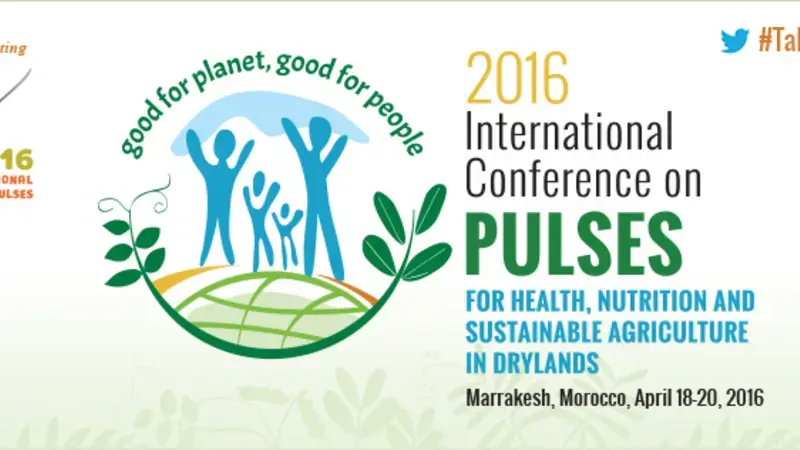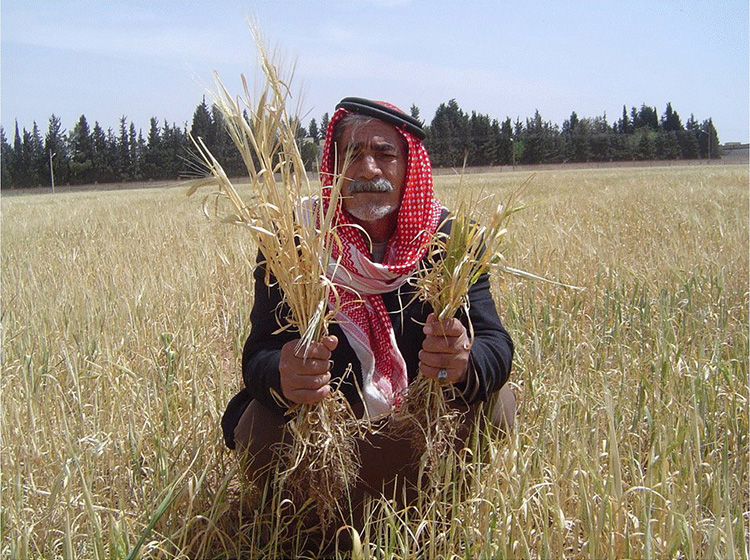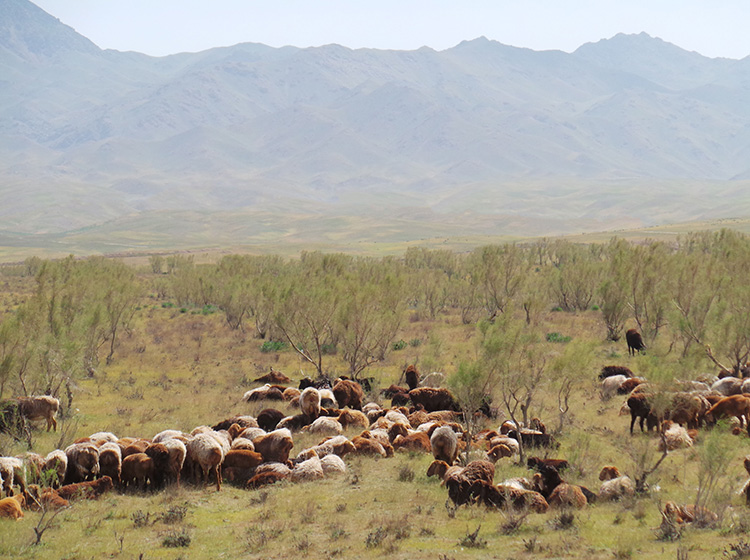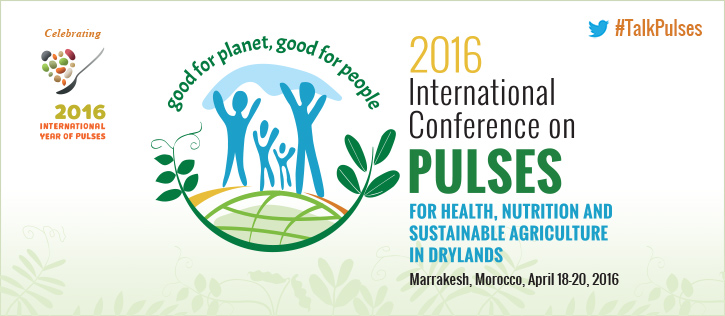Quarterly Newsletter - Issue 5, March 2016

Dear Friends,
We are in full swing at ICARDA and with our partners to make 2016 International Year of Pulses (IYP) a big success, as indeed an increase in pulses production is much needed for a sustainable future of food production. Not only are pulses nutritious food, they are very environment friendly as they replenish soil nutrients and have tiny water and energy footprints. But pulses have gotten left behind in our food systems which now largely revolve around cereals.
This year, we are stepping up our efforts to bring back pulses in our food systems and we are equally pleased to have INRA-Morocco, OCP Foundation, IFAD, FAO, and CGIAR Research Program on Grain Legumes as our partners in organizing International Conference on Pulses for Health, Nutrition and Sustainable Agriculture in Drylands, April 18-20, 2016 in Marrakesh, Morocco.
Sustainable intensification of cereal-based cropping systems with pulses is one of ICARDA’s defining approaches to improve food and nutritional security and sustain productivity in drylands. And we have seen some remarkable successes in past few years with wheat-pulses and rice-pulses systems. At the Conference, we are looking forward to fruitful discussions with scientists, policy-makers, extension workers, traders and entrepreneurs on challenges and solutions, so we can together forge ahead with increasing productivity and profitability of pulses, for both farmers and the food industry.
Farmers are already facing climate variability and change. Pulses will play a critical role in building resilient and sustainable farming systems imperative to meet future food demand. As climate-smart crops, we hope they get the boost they deserve in our diets and on farmers’ fields. We also sincerely hope to unify our efforts with as many stakeholders as possible on this important goal for IYP 2016, which contributes directly to the CGIAR Research Program on Grain Legumes.

With Kind regards,
Mahmoud Solh
Director General, ICARDA
A Final Stepping Stone for Smallholders to Zero-Till Farming

Can sowing the seeds without tilling give better results than the age-old practice of ploughing? Wheat farmers from Hama, Syria found out for themselves when they ventured to experiment their wheat crop with zero till (ZT) and were astounded to find the difference in performance, comparing crop under conventional tillage (in left hand) with that under zero tillage (in right hand).
The practice of zero-till prior to sowing has gained traction in developed countries around the world but often meets with skepticism from farmers in developing countries. As a key component of Conservation Agriculture package, it promotes cropping with minimum soil disturbance, stubble retention, and early sowing. This is important for good yields, especially in rainfed and dryland environments. However, with lack of quantified information and evidence on its economic benefits relative to conventional tillage, farmers are not yet convinced to leave their lands unploughed and risk their livelihoods.
A new study conducted by ICARDA scientists along with the wheat farmers in Syria is set to give a major boost to adoption of zero-till practice. The research established adoption of the ZT technology to result in a US$ 189/ha (33%) increase in net crop income and a 26 kg (34%) gain in per capita wheat consumption per year (adult equivalent) – a meaningful change in the livelihoods of smallholder households.
Zero tillage conserves soil moisture and organic matter, while eliminating the need for fuel, labour and machinery costs. In addition, a reduction in wind and water erosion and an increase in soil organic matter and carbon provide significant environmental benefits. With its capacity for moisture conservation and cost savings, zero tillage can lead to higher yields and increased net returns with reduced variability of yield and income, which is particularly important in dryland farming.
In the Western hemisphere, zero tillage is hailed mainly for its fuel cost saving while it may actually lead to some yield losses in high rainfall situations. However, in the arid areas such as West Asia and North Africa where moisture is a major limiting factor, zero tillage has a positive effect on the soil’s moisture retention capacity. Further, the elimination of tillage operations enables farmers to sow early and make better use of rainfall. These changes lead to higher productive efficiency and yields making its economic benefits three-fold – fuel cost savings, higher productive efficiency and higher yields.
The findings build on the prior progress made by scientists with uptake of zero tillage by working with local manufacturers to develop cheaper prototype ZT seeders with modifications to suit local conditions. By 2011-12, the total area under zero tillage had reached 540 Syrian farmers working on 30,000 ha and was fast growing, spurred by circumstances of limited fuel availability. The ACIAR-funded project had as well successfully introduced zero tillage in northern Iraq, where it was adopted by 100 farmers on an estimated area of 14,050 ha in 2014-15, with benefits comparable to those in Syria.
Supported by: Australian Centre for International Agricultural Research (ACIAR)
The Little Known World of Rangelands and Rights
A chat with Mounir Louhaichi, Principal Rangeland Scientist at ICARDA

Q. When we think of rangelands, we visualize vast expanses of grasslands with animals grazing on them. How do you see rangelands as a scientist?
I see rangelands as massive continuous areas of trees, shrubs and grass, which are not for cropping. They occupy some 260 million hectares in Central Asia alone. In Jordan, 90 percent of land area is rangelands. Historically, they have been primarily used to provide forage for livestock and wildlife. But this vision of rangelands as only grazing lands is narrow. Today, they are recognized for some very important ecosystem services that support our quality of life. A major function is they help mitigate climate change via carbon sequestration. Also they are the cradle of genetic biodiversity stored within the flora and fauna of these environments. Many people don’t realize, their degradation not only affects pastoralists but also affects quality of life in urban areas. For example, when we see sandstorms in Jordan, dust fills the air in cities and this is stemming from degraded rangelands.
Q. Climate change is affecting all environments around us. How is it affecting the pastoralists who rely on rangelands for their livelihood?
Pastoralists typically move from one place to another to manage livestock looking for forage and water. With climate change, we are witnessing more recurrent draughts, while rains that come are in short intense spells, which tend to wash out soils or overwater the plants. This stress on plants has increased competition for grazing from a reduction in vegetation and the pastoralists have to walk their herds further for grass. The stress is also leading to reduction in desirable native species as invasive species are taking over being more able to compete with desirable vegetation. The invasive species are often unpalatable or thorny and not good for livestock.
On the scale of agroecosystem, climate change is increasing desertification in drylands which would undoubtedly have a dramatic impact on rangeland biodiversity, the lifecycle of plants, and productivity.
Q. Land tenure is a hot issue and a critical one for aiding development. How is land tenure playing out for rangelands and affecting pastoral communities who rely on them?
Land tenure is a defining issue for the sustainability of rangelands and therefore, a major focus of our research in Central and West Asia, as well as North Africa. There is a strong link between land tenure and land degradation. Generally speaking, rangelands could belong to three types of stakeholders – state/government, community/tribes which make major part of rangelands tenure or private ownership, which is still a very small fraction. For example, in Central Asia, pastoralists who can afford are doing long-term lease of rangelands from the state, which came into being after the break-down of Soviet Union. This has changed the way land is managed and utilized to a sedentary way of life. When it comes to communal or open access rangelands, there is lack of any regulatory framework. Anybody can come and graze their animals, which creates a sense of anxiety and mistrust amongst herders because there is no shared sense of ownership and hence caretaking.
Q. For many pastoralist communities around the world, their very source of livelihood depends on sustainability of rangelands. However, we need to protect this precious resource from overgrazing anddegradation. What does science tell as the solution?
Counter to our thinking, without grazing, rangelands are bound to deteriorate. Grazing of vegetation at the right time in plant cycle promotes regeneration by spreading of seeds. So long-term protection of rangelands from livestock grazing is not the answer. Instead we need to have a balance between livestock and vegetation and use livestock grazing as a tool to reverse degradation.
The question is how to strike this harmony? Rangeland ecology is very complex and requires a multi-disciplinary approach – social sciences to document the indigenous knowledge stowed with generations of pastoralists; policy mechanisms that are bottom-up to respond to needs of pastoralists and capacity building of institutions to guide the use of rangelands; and finally the scientific interventions to rehabilitate and sustain rangelands. We aim to have greater vegetation cover which means less run-off, higher infiltration and more forage production. For this, we are looking into improved plants and shrubs that are tolerant to stresses including recurrent droughts, salinity, grazing pressure and other stresses that are in play. Water harvesting is another important strategy, e.g., we are using laser-guided Vallerani technique to create micro-catchments in Jordan and grow salt bushes which ensure feed even in driest seasons and which are also protein rich for animals. Soil scarification is another simple technique we use to remove hard top soil that prevents seeds stored in the soil seed bank to germinate and allow rainfall to infiltrate the soil.
A cutting edge method we are experimenting with at ICARDA is the use of GPS collars on animals in desert of Rajasthan (India) to gather insights on parameters such as how often herds graze, what types of plants herds are utilizing, water use, and routes used for migration. These findings can inform land management, policy, and in this case reduce potential conflict by dispelling myths about migratory pastoralism.
We are also looking at the use of GIS and remote sensing to provide instant and cost effective monitoring of vast rangelands at fingertips – this is much needed as management has become more difficult from climate change and increasing anthropogenic pressure.
Q. Is there an example you can share of transition in rangeland management approach that is demonstrating benefits – both for pastoralists and the land.
Rangeland management goes well beyond planting shrubs and vegetation as this may be only a quick fix but not a sustainable solution. Once rangeland has good vegetation cover, it can be severely grazed and left barren in a very short time. A component that is vital for sustainability is a regulatory framework that entitles the pastoralist communities to self-governance and lends a sense of ownership for the rangelands. A project implemented in south of Tunisia, funded by IFAD, has demonstrated this model very well, to the extent, that the project has ended but the communities have kept the self-governance model. They practice rotation of grazing land, allocating areas for resting to enable recovery of vegetation. The initial allocation of 10,000 hectares (ha) produced so much biomass that the community, by their own decision, expanded the practice to some 40,000 ha next year. They function with designated leadership and conflict-resolving groups to facilitate rotation.
Self-governance by communities is going to be the key to ensuring sustainability of this vast natural resource we have. This has been the past practice, but with growing economies and new models of central administration, has come a growing tendency for encroachment of cultivation and appropriating land. The competitiveness over these fragile ecosystems is hurting both pastoralists and the rangelands. An inclusive legal framework can resolve this issue, an approach we are working on with the government in Tunisia and making very good progress.
Supported by: CGIAR Research Programs on Dryland Systems
In the SPOTLIGHT
ICARDA Inaugurates Global Pulses Research Platform in India
The Global Pulses Research Platform, inaugurated February 24 near Bhopal, is a joint initiative of ICARDA with the Indian Council of Agricultural Research, Madhya Pradesh State Government, and the Government of India, to significantly increase pulses production and reduce dependence on imports in the South Asia region through science and capacity building. Read more
Articles contributed by: Rajita Majumdar (Editor) and Pratima Mathews
The International Center for Agricultural Research in the Dry Areas (ICARDA) works with countries in the world's dry and marginal areas to help increase productivity, raise smallholder incomes, improve nutrition and strengthen national food security.

Dryland Systems is global agricultural research partnership to realize the potential of dryland communities. The program is a CGIAR initiative led by ICARDA.

